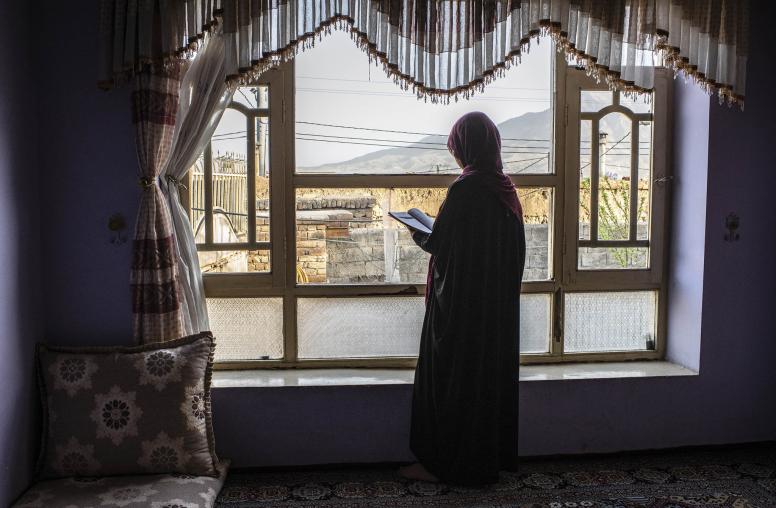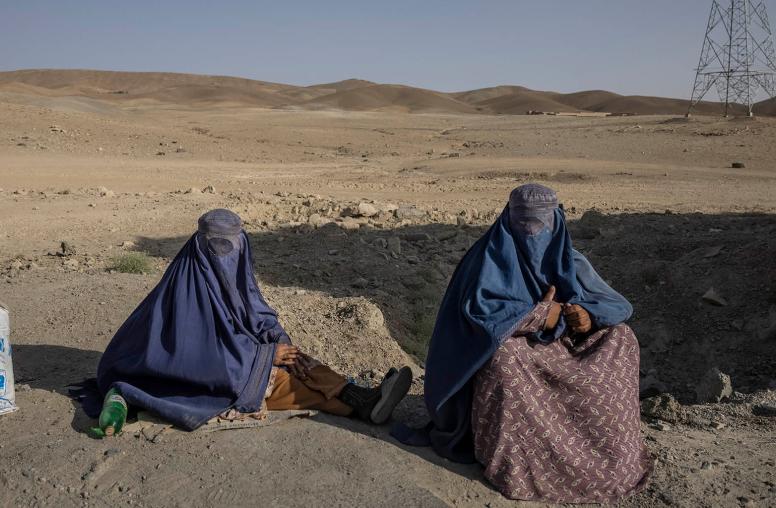Why Have the Wars in Afghanistan and Ukraine Played Out So Differently?
The United States, NATO, national leaders and security forces failed in Afghanistan but not in Ukraine.
The Taliban insurgency and U.S. troop withdrawal, and Russian incursions culminating in the February 24 invasion, constituted existential “stress tests” for Afghanistan and Ukraine, respectively. Ukraine and its international supporters have succeeded in preventing an outright Russian victory, imposing severe and continuing costs on Russia — ranging from high casualties to financial sanctions. Whatever happens next, the invasion has solidified Ukraine’s national will, status and orientation as an independent, Western-oriented sovereign country. In sharp contrast, Afghanistan’s government and security forces collapsed within a month after U.S. troops left the country, its president and many others fled, and the Taliban rapidly took over.

Ukraine’s success and Afghanistan’s collapse came about despite both countries facing messy politics in recent decades (including disputed elections, irregular changes of government and political violence), neighboring countries’ interference, widespread corruption (both countries have been more corrupt than most of their neighbors, according to Transparency International’s Corruption Perceptions Index) and security sector weaknesses. The many differences between the two countries include some that favor Ukraine: far higher level of development and average per capita income; proximity to Europe; 100 percent literacy versus 37 percent in Afghanistan; far better human and social indicators more generally; and much less ethnic fractionalization. Other differences, however, should have favored Afghanistan: its centuries-long history as an independent country and the Taliban’s weakness as compared to Russia. Strikingly, the same external actors — the United States, NATO and its member states — failed in Afghanistan but have more effectively supported Ukraine. What key factors explain success and failure?
Two Different Conflicts
The conflicts in Afghanistan and Ukraine have been fundamentally different. Ukraine is in a defensive conventional and hybrid war against Russia. Afghanistan was subjected to a counterterrorism (CT) intervention in 2001 that morphed into a massive counterinsurgency (CI) effort involving military action, security sector support, development programs and institution building. Moreover, Afghanistan was a focal point for the global war on terror going back to 9/11 and earlier, whereas Ukraine never was. Not being a nexus in that “war” arguably was a success factor in post-conflict transitions to stable peace.
The narrative of foreign invasion was a positive factor for Ukraine but not for Afghanistan. The absence of U.S. and NATO combat forces was conducive to a Ukrainian narrative of Russian aggression and building a unified and effective national response, but in Afghanistan this factor was unfavorable for the previous government. The massive and comprehensive U.S.-led international engagement meant the Afghan government could not credibly characterize the conflict as its own fight, let alone against foreign forces. The Taliban narrative of fighting a jihad against foreign invaders was more credible, even though the Taliban received essential support from Pakistan and elsewhere.
Counterinsurgency Challenges
The CI effort in Afghanistan depended on key success factors that were not in place. Although most insurgencies around the world fail, Afghanistan has been an exception, having seen two victorious insurgencies against great powers in the past 40 years. Government victory in CI requires a long time horizon and certain prerequisites. In particular, it has been virtually impossible to decisively defeat an insurgency if it has access to reliable and durable sanctuaries outside the country. Pakistan never wavered in providing sanctuary for the Taliban, and indeed their headquarters was in Quetta. Moreover, the international military intervention and security sector and stabilization initiatives as well as the Afghan government’s own efforts were plagued by short-termism, not looking out much into the future let alone planning five to 10 years ahead in line with the time required for sustainable success at CI.
NATO was not set up for CI, but the United States should have learned from its own CI experience. NATO, as a defensive alliance designed to deter and defend against a Soviet conventional or nuclear attack, was much better positioned to support Ukraine’s defensive war with Russia than to successfully pursue CI in Afghanistan. However, the United States had extensive experience from Vietnam as well as other, smaller CI efforts. Moreover, there was ample scope for learning from experience during the nearly two decades of the intervention in Afghanistan, as well as for cross-learning between Afghanistan and Iraq. Some lessons from past experience were laid out in the U.S. Army-Marine Corps counterinsurgency manual, but efforts to apply its doctrines did not lead to better outcomes.
Different Security Sector Reform Outcomes
Security sector reform in Ukraine worked, but Afghan National Defense and Security Forces (ANDSF) failed. There is no sugarcoating the collapse of the ANDSF versus Ukrainian security forces’ successful resistance against Russia. The latter gained valuable experience during the post-2014 conflict in the eastern Donbas region, whereas the ANDSF did not appear to learn that much from being trained and mentored by U.S. and other NATO forces as well as working alongside them against the Taliban over more than a decade, and never became able to operate fully independently.
The United States and NATO effectively supported Ukraine’s security sector reform but not the ANDSF. The same external actors (the United States, the NATO alliance and various NATO member countries) were engaged in supporting Ukraine and Afghanistan’s security sectors, with strikingly different results. A crucial difference was that the Afghan Army and police were built from scratchon a new foundation and model, whereas security sector reform in Ukraine was evolutionary, starting small when the country joined NATO’s Partnership for Peace in 1994 and accelerating from 2014 onward.
Unlike in Ukraine, there was enormous built-in ANDSF dependence on unending foreign support. The cost of the ANDSF — equivalent to more than a quarter of Afghanistan’s gross domestic product and funded almost entirely by foreign aid — exceeded that of any other country and could never be covered by domestic revenues. Dependency also encompassed logistics, maintenance (by foreign contractors) and key enablers such as airpower. Though Ukraine effectively absorbed increasing amounts of foreign military equipment in the run-up to the Russian invasion, the share of its security costs covered by aid was small before 2022.
The sheer size and dominance of U.S. and NATO support militated against the success of the ANDSF. Compared to targeted assistance and never more than a handful of foreign military advisors and trainers in Ukraine, international military forces in Afghanistan peaked at well over 100,000 during the 2009-11 “surge” period, and enormous aid resources went into the ANDSF over nearly two decades. International experience suggests that the success of security sector reform has been negatively correlated with the magnitude of foreign involvement and the degree of reliance on foreign models.
Complicated Politics
Both Ukraine and Afghanistan suffered from difficult politics, but this played out differently. Ukrainian political groupings and leaders coalesced against the Russian threat, despite differences among them including in views toward Russia. In two successive post-2014 presidential elections, peaceful transfers of power occurred, and all political parties came together in response to the Russian invasion on February 24. In Afghanistan, all presidential elections after 2004 were disputed, leading to an extra-constitutional National Unity Government in 2014 and competing presidential “inaugurations” after the 2019 election. Even when it was abundantly clear that most or all U.S. troops would be leaving and their combat support to ANDSF was ending, Afghan politicians continued their internecine disputes and did not come together against the Taliban threat.
Wishful Thinking Versus Realism
There was wishful thinking on Afghanistan versus realism, even pessimism, regarding Ukraine. U.S. assessments of ANDSF’s capabilities tended to be excessively rosy, whereas assessments of Ukraine’s ability to resist a full-scale Russian military onslaught were conservative and turned out to be overly pessimistic. Domestically, there seemed to be a remarkable degree of (at least outward) complacency among Afghan non-Taliban political elites that the U.S. troop presence would continue, even in the face of the increasingly clearly expressed U.S. intention to withdraw militarily. While Ukrainian leaders and political elites expressed the hope that Russia would not attack — which may have reflected wishful thinking — this did not inhibit an effective national response to the invasion when it happened.
U.S. troops’ Afghan exit strategy gave rise to distortions, but this was not an issue in Ukraine. The perceived viability, effectiveness and sustainability of the ANDSF were seen as key to the exit of U.S. and other NATO troops from the country. This generated pressure to “show progress” in the development and capabilities of the ANDSF, even if it was not really there, or was not tested in combat. The absence of U.S. combat troops in Ukraine obviated the need for optimistic assessments to justify an exit strategy.
Unlike the mixed messaging on Afghanistan from different U.S. agencies, there was more unified, consistent messaging on Ukraine. In recent years, there were firm top-level political declarations that the United States would be completing the drawdown of its troops in Afghanistan, but also indications of a tug-of-war with the Pentagon, which did not particularly hide its desire for at least a small U.S. troop presence to stay on indefinitely. While not excusing Afghan complacency, this mixed messaging did provide some ammunition for wishful thinking on their part. There was no such semi-public disconnect in U.S. messaging to Ukraine as well as to Russia and more generally.
The United States and NATO had serious contingency plans and preparations for Ukraine but not for Afghanistan. In the case of Ukraine, there was a pre-invasion U.S. and NATO buildup on the country’s western borders and military aid was increased, and then a swift, multipronged response when the invasion occurred, including a sharp acceleration of military aid, large amounts of civilian aid and imposition of drastic sanctions against Russia. In Afghanistan, all eggs seem to have been put in the ANDSF “basket,” with little in the way of a “Plan B” against the Afghan collapse that materialized.
Shifting U.S. Priorities
The United States showed growing fatigue over Afghanistan, but this is not yet the case for Ukraine. The sheer longevity of the intervention in Afghanistan is what was surprising, not that fatigue eventually set in. The U.S. staying power over nearly two decades, though remarkable, was a symptom of the failure to set Afghanistan on a sustained course toward post-conflict stability, and during its second decade reflected inertia and the search for an exit. The key shortcoming was the lack of realistic preparations for the withdrawal of U.S. troops — forecast as early as 2011 and increasingly on the cards under the two most recent U.S. administrations. U.S. and European fatigue over Ukraine may set in at some point, but Ukraine’s resistance and the support provided by its Western partners has prevented an outright Russian victory.
Afghanistan became increasingly peripheral to U.S. national security interests, while Ukraine is more central. As time elapsed after 9/11 — especially after the killing of Osama bin Laden in Pakistan nearly a decade later — the original CT justification for the U.S.-led intervention in Afghanistan weakened and looked increasingly out of line with its huge size and cost. Ukraine’s location in Europe and Russia’s 2014 incursion enhanced Ukraine’s centrality to U.S. national security interests. Russia’s full-scale invasion has the potential to destroy the rules-based international order in Europe, which depends on respect for countries’ sovereignty and territorial integrity. An independent, sovereign Ukraine, therefore, has become central to broader U.S. and global security. Afghanistan, in contrast, was a high-priority focus of U.S. national security policy — until it was not.
The views expressed in this publication are those of the author(s).



